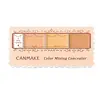What's inside
What's inside
 Key Ingredients
Key Ingredients

 Benefits
Benefits

 Concerns
Concerns

 Ingredients Side-by-side
Ingredients Side-by-side

Isotridecyl Isononanoate
EmollientMethyl Methacrylate Crosspolymer
Synthetic Wax
AbrasiveAlumina
AbrasiveMicrocrystalline Wax
Emulsion StabilisingPolyglyceryl-2 Triisostearate
EmulsifyingSorbitan Sesquiisostearate
EmulsifyingDimethicone
EmollientSilica
AbrasivePolyhydroxystearic Acid
EmulsifyingPhytosteryl/Octyldodecyl Lauroyl Glutamate
Skin ConditioningSqualane
EmollientMagnesium Carbonate
AbsorbentTocopherol
AntioxidantPolymethylsilsesquioxane
Methicone
EmollientSodium Hyaluronate
HumectantCI 77891
Cosmetic ColorantMica
Cosmetic ColorantCI 77491
Cosmetic ColorantCI 77492
Cosmetic ColorantCI 77499
Cosmetic ColorantTriethylhexanoin
MaskingMicrocrystalline Cellulose
AbsorbentIsotridecyl Isononanoate, Methyl Methacrylate Crosspolymer, Synthetic Wax, Alumina, Microcrystalline Wax, Polyglyceryl-2 Triisostearate, Sorbitan Sesquiisostearate, Dimethicone, Silica, Polyhydroxystearic Acid, Phytosteryl/Octyldodecyl Lauroyl Glutamate, Squalane, Magnesium Carbonate, Tocopherol, Polymethylsilsesquioxane, Methicone, Sodium Hyaluronate, CI 77891, Mica, CI 77491, CI 77492, CI 77499, Triethylhexanoin, Microcrystalline Cellulose
Silica
AbrasiveSimmondsia Chinensis Seed Oil
EmollientGlycerin
HumectantButylene Glycol
HumectantHelianthus Annuus Seed Oil Unsaponifiables
EmollientSqualane
Emollient1,2-Hexanediol
Skin ConditioningBrassica Oleracea Gemmifera Extract
AstringentSolanum Lycopersicum Fruit Extract
AntioxidantLecithin
EmollientSimmondsia Chinensis Leaf Extract
HumectantLeontopodium Alpinum Extract
Skin ConditioningHydrogenated Lecithin
EmulsifyingPhoenix Dactylifera Seed
Skin ConditioningAscorbic Acid
AntioxidantTromethamine
BufferingDipotassium Glycyrrhizate
HumectantCeramide NP
Skin ConditioningSodium Metabisulfite
AntioxidantSodium Sulfite
PreservativeSilica, Simmondsia Chinensis Seed Oil, Glycerin, Butylene Glycol, Helianthus Annuus Seed Oil Unsaponifiables, Squalane, 1,2-Hexanediol, Brassica Oleracea Gemmifera Extract, Solanum Lycopersicum Fruit Extract, Lecithin, Simmondsia Chinensis Leaf Extract, Leontopodium Alpinum Extract, Hydrogenated Lecithin, Phoenix Dactylifera Seed, Ascorbic Acid, Tromethamine, Dipotassium Glycyrrhizate, Ceramide NP, Sodium Metabisulfite, Sodium Sulfite
 Reviews
Reviews

Ingredients Explained
These ingredients are found in both products.
Ingredients higher up in an ingredient list are typically present in a larger amount.
Silica, also known as silicon dioxide, is a naturally occurring mineral. It is used as a fine, spherical, and porous powder in cosmetics.
Though it has exfoliant properties, the function of silica varies depending on the product.
The unique structure of silica enhances the spreadability and adds smoothness, making it a great texture enhancer.
It is also used as an active carrier, emulsifier, and mattifier due to its ability to absorb excess oil.
In some products, tiny microneedles called spicules are made from silica or hydrolyzed sponge. When you rub them in, they lightly polish away dead skin layers and enhance the penetration of active ingredients.
Learn more about SilicaSqualane is an emollient that helps the skin hold onto moisture. It's an oily liquid that occurs naturally in certain types of fish and plant oils.
Because squalane boosts hydration in the skin, it also comes with plenty of benefits: it is an antioxidant and can help fight free radicals and skin damage. Squalane is also found to have a detoxifying effect when applied.
Squalane comes from squalene, which occurs naturally within the sebum of our skin. It is one of the oils our skin produces to keep itself hydrated. Squalane is the hydrogenated version of squalene and has a longer shelf life.
Research shows that squalane is non-irritating (even at 100% concentration).
In general, it's a fantastic ingredient. It does a great job at hydrating the skin, and it's suitable for those with sensitive skin.
The source of squalane may impact malassezia / fungal acne. This is because olive oil derived squalane can contain impurities such as fatty acids and plant waxes. Sugarcane derived squalane is recommended for anyone with malassezia concerns.
Is squalane vegan?
This depends on the source. Squalane can be derived from both plants and animals. Most squalane used in skincare comes from plants.
Please note: the source of squalane is only known if disclosed by the brand. We recommend reaching out to the brand if you have any questions about their squalane.
Read more about squalene with an "e".
Is squalane an oil?
Squalane is often called an oil, but it’s technically not; it’s a hydrocarbon, meaning it’s only made of carbon and hydrogen, unlike true oils which are triglycerides made of fatty acids and glycerol.
The term “oil-free” isn’t regulated, so companies can define it however they want. Some exclude all oils, while others just avoid mineral oil or comedogenic oils.
While some people avoid oils thinking they cause breakouts, the right kind of oil (or oil-like ingredient like squalane) can actually help balance and hydrate your skin. It’s worth testing out simple oils or squalane to see what works best for your skin.
Learn more about Squalane